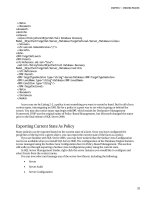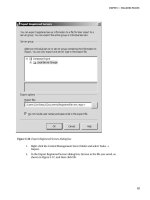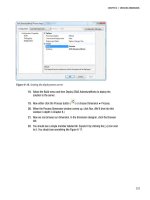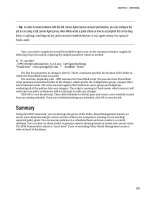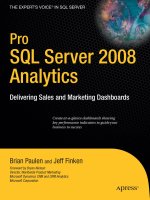Pro SQL Server 2008 Policy-Based Management- P4
Bạn đang xem bản rút gọn của tài liệu. Xem và tải ngay bản đầy đủ của tài liệu tại đây (1.46 MB, 50 trang )
CHAPTER 6 POLICY-BASED MANAGEMENT INTERNALS
Note: You can also enable and disable Policy-Based Management from the context menu that appears when you
right-click the Policy Management node.
HistoryRetentionInDays: Specifies the number of days the server keeps policy
evaluation history in its tables. By default, this option is set to 0, which means
historical evaluation data is not automatically removed from the table in the msdb
database. You may want to change the value for this property to retain history for a
reasonable length of time, such as 30 days, in order to avoid unnecessarily bloating
the size of the msdb database. However, your auditing requirements may dictate the
amount of history you need to retain. The cleanup job is handled by a scheduled
job under the SQL Server Agent called syspolicy_purge_history, which runs every
day at 2:00 AM, by default. This cleanup job is created automatically when you
install SQL Server 2008.
LogOnSuccess: Specifies whether Policy-Based Management logs successful policy
evaluations. By default, only failed evaluations are logged to the
syspolicy_policy_execution_history_details_internal table. Logging successful
evaluations can be useful if you are doing any reporting on the current state of a
policy. If only failed evaluations are logged, you will not know if the policy is still in
a failed state or if it has met the requirements in a subsequent evaluation.
Alternatively, you can query the syspolicy_configuration view in the msdb database to determine
your currently configured values using the query in Listing 6-1.
Listing 6-1. Query to determine the current property settings for Policy-Based Management
SELECT CAST(serverproperty(N'Servername') AS sysname) AS [Name],
CAST((SELECT current_value
FROM msdb.dbo.syspolicy_configuration
WHERE name = 'Enabled')
AS bit) AS [Enabled],
CAST((SELECT current_value
FROM msdb.dbo.syspolicy_configuration
WHERE name = 'HistoryRetentionInDays')
AS int) AS [HistoryRetentionInDays],
CAST((SELECT current_value
FROM msdb.dbo.syspolicy_configuration
WHERE name = 'LogOnSuccess')
AS bit) AS [LogOnSuccess]
There is one row in the syspolicy_configuration view that you don’t see in the Policy Management
Properties dialog box: the globally unique identifier (GUID) of the job that actually cleans up the policy
history. You can join this GUID to the sysjobs table to find out other information about the purge history
job, as shown in Listing 6-2.
Please purchase PDF Split-Merge on www.verypdf.com to remove this watermark.
133
CHAPTER 6 POLICY-BASED MANAGEMENT INTERNALS
Listing 6-2. Query to view information about the purge history job
SELECT sc.name AS PropertyName,
job_id,
sj.name AS JobName,
[enabled]
FROM msdb.dbo.syspolicy_configuration sc JOIN
msdb.dbo.sysjobs sj ON
CAST(current_value as uniqueidentifier) = sj.job_id
WHERE sc.name = 'PurgeHistoryJobGuid'
Note: An interesting thing about these Policy-Based Management properties is that there is no facet to manage
them. For example, you couldn’t create a policy that ensured that HistoryRetentionInDays was always set to 30
without using a custom SQL script. There is an active suggestion on Microsoft Connect to add a facet for these
properties ( It looks like the suggestion is on the radar for SQL Server 11. If you think this would be a valuable
addition, make sure to visit this page to vote.
Policy-Based Management Architecture
The architecture of Policy-Based Management is composed of many different components within SQL
Server. In addition, completely different components may be used depending on the policy evaluation
mode: On Demand, On Change: Prevent, On Change: Log Only, or On Schedule. Here, we will look at the
architecture used by each evaluation mode.
Keep in mind that the configuration settings and historical information about Policy-Based
Management are housed in the msdb database. In addition, even though you can evaluate a policy
directly from the file system, the only way you can evaluate a policy is On Demand, unless it is stored in
the msdb database.
On Demand
On Demand is the simplest form of evaluation and lays the foundation for the remaining evaluation
modes. Policy-Based Management is built on top of SQL Server Management Objects (SMO), a
collection of objects used when programming to interact with SQL Server. When you evaluate a policy,
the Policy Engine checks the current state of an object, or target, using SMO against the desired state you
have defined by the conditions of your policy. This behavior is true for the remaining evaluation modes
as well.
134
Please purchase PDF Split-Merge on www.verypdf.com to remove this watermark.
CHAPTER 6 POLICY-BASED MANAGEMENT INTERNALS
Note: SQL Server 2000, 2005, and 2008, support SMO, which is why Policy-Based Management works with all
of these versions as well. However, Policy-Based Management also takes advantage of some new features in SQL
Server 2008, which is why you have limited functionality with prior versions.
On Change: Prevent
When using the On Change: Prevent mode, SQL Server takes advantage of Data Definition Language
(DDL) triggers to actually prevent changes from occurring if they violate a policy. Since these changes
must be prevented before the changes are committed, the Policy Engine uses a Common Language
Runtime (CLR) wrapper so it can handle the process within a transaction.
The complete process for On Change: Prevent is as follows:
x
Database Engine Eventing sends DDL events synchronously to the Policy Event
Handler.
x
The Policy Event Handler invokes the Policy Engine, which evaluates the policy.
x
If the policy fails, the change is committed; otherwise, the change is rolled back.
To increase performance, the Policy Event Handler is listening for only events that coincide with
enabled policies. If you don’t have any policies enabled, the Policy Event Handler will not be listening for
any events. Furthermore, if all of your enabled policies are using the Server facet, the Policy Event
Handler will be listening for only server events.
On Change: Log Only
Since policy violations only need to be logged (not prevented) when using the On Change: Log Only
mode, Policy-Based Management can take advantage of asynchronous processing. This asynchronous
processing is performed by using trace events in conjunction with Service Broker.
The complete process for On Change: Log Only is as follows:
x
Database Engine Eventing sends trace events asynchronously to a Service Broker
queue.
x
Service Broker sends the events to the Policy Event Handler.
x
The Policy Event Handler invokes the Policy Engine, which evaluates the policy.
x
If the policy fails, the event is logged.
On Schedule
When using the On Schedule mode, Policy-Based Management uses the SQL Server Agent and
PowerShell to execute policies at a given time. Since these policies are executed outside the Database
Engine, Policy-Based Management uses PowerShell, rather than CLR, as a wrapper for the Policy Engine.
When you schedule a policy, a SQL Server Agent job is automatically created with two steps. The
first step checks to see if the Policy-Based Management is enabled using the function
Please purchase PDF Split-Merge on www.verypdf.com to remove this watermark.
135
CHAPTER 6 POLICY-BASED MANAGEMENT INTERNALS
fn_syspolicy_is_automation_enabled (shown in Listing 6-3). If Policy-Based Management is enabled,
the job proceeds to the next step, which uses PowerShell to invoke the Policy Engine and evaluate the
policy.
Listing 6-3. Function used to determine if Policy-Based Management is enabled
CREATE FUNCTION fn_syspolicy_is_automation_enabled()
RETURNS bit
AS
BEGIN
DECLARE @ret bit;
SELECT @ret = CONVERT(bit, current_value)
FROM msdb.dbo.syspolicy_configuration
WHERE name = 'Enabled'
RETURN @ret;
END
Notice that the function in Listing 6-3 uses the syspolicy_configuration view we discussed in the
Properties section earlier in the chapter.
You can create your own job in SQL Server that uses the function in Listing 6-3 to make sure PolicyBased Management is enabled using the script in Listing 6-4. If the job fails, you could send an alert
notification informing you that Policy-Based Management is disabled.
Listing 6-4. Script to see if Policy-Based Management is enabled
IF (msdb.dbo.fn_syspolicy_is_automation_enabled() != 1)
BEGIN
RAISERROR(34022, 16, 1)
END
Policy-Based Management Security Issues
Security for Policy-Based Management centers around two elements:
PolicyAdministratorRole: A database role that allows those holding it to create and
edit policies.
##MS_PolicyTsqlExecutionLogin##: A proxy login used by Policy-Based
Management when you schedule a policy that makes use of the ExecuteSQL()
function. By default, the proxy login has very little access. You’ll need to grant the
necessary login access to execute the SQL that you schedule.
The role gives you control over who can define and edit policies. The login gives you control over
SQL statements that those policies execute.
When you manually execute a policy, any SQL executed via the ExecuteSQL() function executes
under your own username. It is as if you had logged in and executed that SQL. But when a policy
execution is triggered by a schedule, any SQL gets executed under the proxy login. Thus, you should take
the following into account when using ExecuteSQL():
136
Please purchase PDF Split-Merge on www.verypdf.com to remove this watermark.
CHAPTER 6 POLICY-BASED MANAGEMENT INTERNALS
x
Grant no unnecessary access to ##MS_PolicyTsqlExecutionLogin##.
x
Any access you grant to ##MS_PolicyTsqlExecutionLogin## is effectively available
to any user holding the PolicyAdministratorRole.
x
When you create a policy to execute manually, be sure that your own login has the
necessary privileges and roles to execute the SQL for that policy.
x
When you create a policy to execute on schedule, you’ll need to grant needed
access to the ##MS_PolicyTsqlExecutionLogin## user.
Remember that these concerns apply only when creating a policy that uses ExecuteSQL(). None of
these issues apply to facet-based policies.
Whether or not you use ExecuteSQL() depends on the demands of your environment. If you do, be
sure to keep strong control over the PolicyAdministratorRole. Know who has the role and why. Do not
give the role out gratuitously. Likewise, take care in granting access to the
##MS_PolicyTsqlExecutionLogin## user. Realize that any access granted to the user is effectively granted
to any other user holding the rule.
Tip: Keep an eye out for new facets in upcoming releases of SQL Server. It is likely that policies that can now
be enforced only through calls to ExecuteSQL() will in the future be enforceable through facets. As Microsoft
updates SQL Server from release to release, watch for opportunities to convert SQL-based policies into facetbased policies. Each opportunity to convert is a potential opportunity to revoke access by the
##MS_PolicyTsqlExecutionLogin## user, thus enhancing your overall security.
You may also notice another login called ##MS_PolicyEventProcessingLogin##. This login is used by
server-level DDL events, as well as by the activation procedure sp_syspolicy_events_reader, which is
used to process messages in the Service Broker-called syspolicy_event_queue. This login is used only
internally, and you should not need to manage any permissions pertaining to it.
Policy-Based Management Tables and Views
To see how Policy-Based Management is organized, we will look at its table structure within the msdb
database, and then at some of the views that use these tables, which will give you a better understanding
of how Policy-Based Management uses the tables internally.
Tables
Figure 6-2 illustrates how the tables in the msdb database relate to each other.
Please purchase PDF Split-Merge on www.verypdf.com to remove this watermark.
137
CHAPTER 6 POLICY-BASED MANAGEMENT INTERNALS
Figure 6-2. Policy-Based Management entity relationship diagram
You may not ever need to query the tables, but it’s good to know that they exist, and to have some
idea of the possibilities that they offer.
Contents of System Policy Tables
Following is a list of the tables shown in Figure 6-2, with brief descriptions of what each contains.
syspolicy_conditions_internal: Contains all conditions existing on the server.
These conditions can also be viewed via SQL Server Management Studio, from the
Conditions folder under Policy Management. The table contains information such
138
Please purchase PDF Split-Merge on www.verypdf.com to remove this watermark.
CHAPTER 6 POLICY-BASED MANAGEMENT INTERNALS
as condition ID, creation date, description, created by, date last modified, and
expression. The expression column holds the XML structure of the condition itself.
syspolicy_configuration_internal: Contains all of the properties for the PolicyBased Management configuration. These are the same properties you saw in the
SQL Server Management Studio Policy Management Properties dialog box (Figure
6-1) earlier in the chapter.
syspolicy_execution_internal: Holds temporary data used to evaluate a policy.
DDL triggers call the sp_syspolicy_dispatch_event stored procedure, which in turn
inserts the event data into this table. You will probably never see any data in this
table, because it is deleted at the end of each process.
syspolicy_facet_events: Contains the various event names and target types
associated with a particular policy’s triggered action. For example, a policy that
enforces naming standards when creating new stored procedures would have a
management_facet_id of 61, which associates with the event CREATE_PROCEDURE and
target type PROCEDURE, as shown in Figure 6-3.
syspolicy_management_facets: Contains a listing of all the facets exposed. This
table includes the ID for the facet, the facet name, and the execution mode that
facet is able to utilize.
syspolicy_object_sets_internal: Contains a listing of relationships between
existing conditions and their related facets.
syspolicy_policies_internal: Contains detailed information on policies existing
on the server. Useful information available in this table includes the policy name,
condition ID associated with the policy, creation date, policy category ID, policy
description, is_enabled flag, created/modified dates, and created by.
syspolicy_policy_categories_internal: Contains a listing of category groups for
policies. The mandate_database_subscriptions column tells you which policy
categories automatically force policy subscription to all databases. A value of 1 (the
default) means all databases on the server subscribe to policies within this
category. A value of 0 means the category is not mandated, and so a policy
administrator (or someone with database owner rights on the database) can
choose to subscribe to a category of policies for a given database.
syspolicy_policy_category_subscriptions_internal: Contains databases that
explicitly subscribe to a given policy. By default, created policies are mandated to
all databases. If a category is not mandated and has explicit subscribers to its
category, then that information is kept in this table. Data kept includes target type
for the policy, the name of the database (target_object) subscribing to the
category, and the category ID.
syspolicy_policy_execution_history_details_internal: Contains detailed results
from policy evaluations that have resulted in a failed policy state. If you wish to see
detailed results from all policy evaluations, you must change the LogOnSuccess
value to True from within the Policy Management properties. Details include the
target of the executed policy (target_query_expression), the target expression with
ID, execution date, Boolean value of the result (0 for success and 1 for failure),
result detail in XML format, and any exception messages.
Please purchase PDF Split-Merge on www.verypdf.com to remove this watermark.
139
CHAPTER 6 POLICY-BASED MANAGEMENT INTERNALS
syspolicy_policy_execution_history_internal: Contains information similar to
the previous table, only result details are limited. The information in this table
includes policy ID, start and end date of the execution, Boolean result of the
execution (0 for success and 1 for failure), and any exception messages.
syspolicy_system_health_state_internal: Contains information about the current
health state for failed targets. This table is populated only when the policy is
enabled. If the table contains data and you disable the policy, the data for that
policy is removed immediately.
syspolicy_target_set_levels_internal: Specifies the levels a given policy targets,
such as file, file group, stored procedure, or database.
syspolicy_target_sets_internal: Specifies the target type of a given policy and
whether that policy set is enabled.
Figure 6-3. Sample data held in the syspolicy_facet_events table
140
Please purchase PDF Split-Merge on www.verypdf.com to remove this watermark.
CHAPTER 6 POLICY-BASED MANAGEMENT INTERNALS
Checking for New Tables
Since Policy-Based Management is a new feature, you never know when new tables will be added to the
msdb database. You can get a listing of all the Policy-Based Management tables, including the creation
date, using the query in Listing 6-5.
Listing 6-5. Query to get a listing of the Policy-Based Management tables
SELECT *
FROM msdb.sys.tables
WHERE name LIKE 'syspolicy%'
ORDER BY name
Views
Policy-Based Management also has a series of system views used by several internal operations. Many of
these views simply query the base table directly; others provide additional logic. By creating views that
query the base table, it is easy for Microsoft to create an abstraction layer between the code and the
database. It is easy to add logic to a view to handle certain situations, such as always returning disabled
for SQL Server Express edition, without needing to change application code.
The views described in this section allow you to query useful information without the need to know
the relationships of the underlying tables. Note that querying the system policy views requires
membership in the PolicyAdministratorRole in the msdb database.
Note: Currently, some of the views discussed here are documented in SQL Server Books Online (four are not).
Two of those that are discussed in the documentation are named incorrectly there.
syspolicy_conditions
The syspolicy_conditions view displays one row for each condition and allows you to determine who
created or last changed a condition. You can see by the following definition that the view joins the
syspolicy_conditions_internal table with the syspolicy_management_facets table to display the facet
name as well.
SELECT c.condition_id,
c.name,
c.date_created,
c.description,
c.created_by,
c.modified_by,
c.date_modified,
c.is_name_condition,
mf.name AS facet,
c.expression,
c.obj_name
Please purchase PDF Split-Merge on www.verypdf.com to remove this watermark.
141
CHAPTER 6 POLICY-BASED MANAGEMENT INTERNALS
FROM [dbo].[syspolicy_conditions_internal] c LEFT OUTER JOIN
[dbo].[syspolicy_management_facets] mf ON
c.facet_id = mf.management_facet_id
syspolicy_configuration
syspolicy_configuration is an undocumented view. However, you can see by the following definition
that it is just displaying the data from the syspolicy_configuration_internal table with one additional
check. If the engine edition is 4, which is Express edition, then the view returns 0 for enabled, no matter
what the actual value is in the table.
SELECT name,
CASE WHEN name = N'Enabled' and
SERVERPROPERTY('EngineEdition') = 4
THEN 0
ELSE current_value
END AS current_value
FROM [dbo].[syspolicy_configuration_internal]
syspolicy_object_sets
syspolicy_object_sets is an undocumented view that correlates an object set such as Database Auto
Close_ObjectSet to a facet such as IDatabasePerformanceFacet. The definition is a follows.
SELECT os.object_set_id,
os.object_set_name,
os.facet_id,
facet.name as facet_name
FROM [dbo].[syspolicy_object_sets_internal] AS os INNER JOIN
[dbo].[syspolicy_management_facets] AS facet ON
os.facet_id = facet.management_facet_id
syspolicy_policies
Among other detailed information, the syspolicy_policies view allows you to determine if a policy is
enabled and who created or changed any policy. As you can see by the following definition, this view is
just a straightforward query from the syspolicy_policies_internal table.
SELECT policy_id,
name,
condition_id,
root_condition_id,
date_created,
execution_mode,
policy_category_id,
schedule_uid,
description,
help_text,
142
Please purchase PDF Split-Merge on www.verypdf.com to remove this watermark.
CHAPTER 6 POLICY-BASED MANAGEMENT INTERNALS
help_link,
object_set_id,
is_enabled,
job_id,
created_by,
modified_by,
date_modified
FROM [dbo].[syspolicy_policies_internal]
syspolicy_policy_categories
The syspolicy_policy_categories view is incorrectly named as syspolicy_groups in SQL Server Books
Online. This view displays a list of groups within Policy-Based Management and also lets you see if a
given policy is mandated as an explicit database subscription. As you can see by the following definition,
this view is a simple query against the syspolicy_policy_categories_internal table.
SELECT policy_category_id,
name,
mandate_database_subscriptions
FROM [dbo].[syspolicy_policy_categories_internal]
syspolicy_policy_category_subscriptions
The syspolicy_policy_category_subscriptions view is incorrectly named in SQL Server Books Online as
syspolicy_policy_group_subscriptions. This view shows the targets that are subscribed to policy
categories. As you can see by the following definition, the view simply queries the
syspolicy_policy_category_subscriptions_internal table.
SELECT policy_category_subscription_id,
target_type,
target_object,
policy_category_id
FROM [dbo].[syspolicy_policy_category_subscriptions_internal]
syspolicy_policy_execution_history
The syspolicy_policy_execution_history view contains general historical information on policies, such
as the date and time the policy tried to run, the time the policy completed running, success or failure
result, and any exception messages that may have occurred during evaluation. The definition follows.
SELECT history_id,
policy_id,
start_date,
end_date,
result,
exception_message,
exception
FROM [dbo].[syspolicy_policy_execution_history_internal]
Please purchase PDF Split-Merge on www.verypdf.com to remove this watermark.
143
CHAPTER 6 POLICY-BASED MANAGEMENT INTERNALS
syspolicy_policy_execution_history_details
syspolicy_policy_execution_history_details provides a more detailed view of the execution history for
a policy. When troubleshooting Policy-Based Management, this is the preferred view to query, as it
shows which target and condition expression combinations failed and when they failed, with a review of
related errors. The definition follows.
SELECT detail_id,
history_id,
target_query_expression,
execution_date,
result,
result_detail,
exception_message,
exception
FROM [dbo].[syspolicy_policy_execution_history_details_internal]
syspolicy_system_health_state
The syspolicy_system_health_state view shows the most recent health state of a target query
expression for each enabled policy in the instance. The definition follows.
SELECT health_state_id,
policy_id,
last_run_date,
target_query_expression_with_id,
target_query_expression,
result
FROM [dbo].[syspolicy_system_health_state_internal]
syspolicy_target_set_levels
syspolicy_target_set_levels is an undocumented view that specifies the levels a given policy targets,
such as file, file group, stored procedure, or database. The definition follows.
SELECT target_set_level_id,
target_set_id,
type_skeleton,
condition_id,
level_name
FROM [dbo].[syspolicy_target_set_levels_internal]
syspolicy_target_sets
syspolicy_target_sets is another undocumented view that specifies the target type of a given policy and
whether that policy set is enabled. The definition follows.
SELECT target_set_id,
144
Please purchase PDF Split-Merge on www.verypdf.com to remove this watermark.
CHAPTER 6 POLICY-BASED MANAGEMENT INTERNALS
object_set_id,
type_skeleton,
type,
enabled
FROM [dbo].[syspolicy_target_sets_internal]
Combining Views
You can combine many of these views to provide useful information. Listing 6-6 shows a sample query
that combines four views to display detailed information about policy failures.
Listing 6-6. Query to display detailed information about policy failures
SELECT sp.name AS Policy,
sc.name AS Condition,
spehd.target_query_expression,
spehd.execution_date,
spehd.exception_message,
spehd.exception
FROM msdb.dbo.syspolicy_policies AS sp JOIN
msdb.dbo.syspolicy_conditions AS sc
ON sp.condition_id = sc.condition_id JOIN
msdb.dbo.syspolicy_policy_execution_history AS speh
ON sp.policy_id = speh.policy_id JOIN
msdb.dbo.syspolicy_policy_execution_history_details AS spehd
ON speh.history_id = spehd.history_id
WHERE spehd.result = 0
Figure 6-4 shows an example of the output of Listing 6-6.
Figure 6-4. Sample output returned by running the query in Listing 6-6
Please purchase PDF Split-Merge on www.verypdf.com to remove this watermark.
145
CHAPTER 6 POLICY-BASED MANAGEMENT INTERNALS
Checking for New Views
As with the Policy-Based Management tables, SQL Server may add new Policy-Based Management views
to the msdb database at any time. You can get a listing of all the Policy-Based Management views,
including the creation date, using the query in Listing 6-7.
Listing 6-7. Query to get a listing of the Policy-Based Management views
SELECT *
FROM msdb.sys.views
WHERE name LIKE 'syspolicy%'
ORDER BY name
Stored Procedures
As a DBA, you might want to take advantage of certain features without being restricted to using the GUI,
or you may need to be able to use functionality via scripting for automation purposes. Taking advantage
of the existing logic in stored procedures is a big help in the scripting process.
There are 43 Policy-Based Management stored procedures in the dbo schema and 5 in the sys
schema, so we will not cover individual stored procedures in this section. However, we will show you
how to find these stored procedures and provide an example of using them for scripting purposes.
You can run the query in Listing 6-8 to return all the stored procedures used by Policy-Based
Management.
Listing 6-8. Query to return Policy-Based Management stored procedures
SELECT SCHEMA_NAME(schema_id) AS SchemaName,
*
FROM msdb.sys.all_objects
WHERE type = 'P' AND
name like 'sp_syspolicy%'
ORDER BY name
The query in Listing 6-8 should return 48 rows if you are using SQL Server 2008 Service Pack 1. If you
want to view the definitions of any of these stored procedures, you can use sp_helptext followed by the
procedure name. For example, sp_helptext 'sp_syspolicy_rename_policy_category' will return the
definition for the sp_syspolicy_rename_policy_category stored procedure, as shown in Figure 6-5.
146
Please purchase PDF Split-Merge on www.verypdf.com to remove this watermark.
CHAPTER 6 POLICY-BASED MANAGEMENT INTERNALS
Figure 6-5. Stored procedure definition returned by using sp_helptext
Now let’s say you wanted to rename a category on one of your servers. No big deal, right? Just go
into SQL Server Management Studio and rename the category. But suppose you need to repeat this 50 or
even 100 times (depending on the number of servers you have). The scripting option is starting to sound
a little better. If you have all your servers set up using a Central Management Server, you can just run
that script on your Central Management Server groups, greatly reducing the time it takes to do a simple
maintenance task. You could script the task by using the following statement:
EXEC msdb.dbo.sp_syspolicy_rename_policy_category
@name=N'OldPolicyName',
@new_name=N'NewPolicyName'
Please purchase PDF Split-Merge on www.verypdf.com to remove this watermark.
147
CHAPTER 6 POLICY-BASED MANAGEMENT INTERNALS
Tip: It is a good idea to perform an action on a contained environment and capture the events that occur using
SQL Server Profiler. By using SQL Server Profiler, you can capture the exact chain of events Microsoft uses to
perform the same action in order to make sure your scripts cover those same actions.
Summary
In this chapter, we looked at the properties you can configure for Policy-Based Management itself,
including whether it is enabled, the amount of history retained, and the type of logging being performed.
Next, we covered the architecture of Policy-Based Management and how it differs by evaluation mode.
Then we took a look at some security considerations related to Policy-Based Management. Finally, we
covered the physical database objects used by Policy-Based Management, including tables, views, and
stored procedures. The more knowledge you have about the way Policy-Based Management works
internally, the more you can customize it to fit your environment.
148
Please purchase PDF Split-Merge on www.verypdf.com to remove this watermark.
CHAPTER 7
Practical Uses of Policy-Based
Management
Like any feature, Policy-Based Management is useful only if it can help you in solving real-world
problems. In this chapter, we’ll show you how you can benefit from using specific policies in your SQL
Server environment. First, we’ll present a sample list of checks commonly performed by DBAs. Then
we’ll look at custom and predefined policies that will perform those checks for you automatically.
A DBA Checklist
Every DBA has a list of items to check on a daily, weekly, and monthly basis. For example, you may want
to ensure the following conditions are true for each of your servers:
x
Databases have sufficient free space.
x
Transaction logs were backed up.
x
SQL Server Agent is running.
x
All SQL Server Agent jobs have notification on failure.
x
Data purity checking is enabled.
x
No databases have autoclose enabled.
x
No databases have autoshrink enabled.
x
Each database has had a full backup taken in the last 24 hours.
x
Backup and data file locations are on different disks.
Of course, some of these checks might be irrelevant to you, depending on your situation. For
example, if you’re the only DBA, then you can be self-policing on some tasks, such as making sure that
you never create a database with autoclose or autoshrink enabled. But even so, automation can work in
your favor as a second line of defense. By automating checks that you would not otherwise perform on a
consistent basis, you give yourself an additional layer of security.
By using the best practice policies defined by Microsoft and supplementing them with your own
custom policies, you can optimize and centralize some (if not all) of your check list requirements. In this
way, Policy-Based Management makes your job easier. In the remainder of this chapter, we will look at
policies to handle the items on our sample check list.
Please purchase PDF Split-Merge on www.verypdf.com to remove this watermark.
149
CHAPTER 7 PRACTICAL USES OF POLICY-BASED MANAGEMENT
Custom Policies
Creating custom policies allows you build on the best practice policies that are provided from Microsoft
and develop a more comprehensive view of your environment. By tapping into the available facets and
their properties, you can create your own conditions and policies to evaluate the SQL Server instances in
your system. Here, we’ll present several custom policies that we’ve found helpful. You’re free to take
them as is, or to modify them to suit your own needs and environment.
NOTE: All of the policies in this chapter use a custom category called AutoEvaluate Policy. You can create
the new category by running the following script.
Declare @policy_category_id int
EXEC msdb.dbo.sp_syspolicy_add_policy_category
@name=N'AutoEvaluatePolicy',
@policy_category_id=@policy_category_id OUTPUT,
@mandate_database_subscriptions=True
Select @policy_category_id
Database Free Space
It is good practice to keep a handle on the size and amount of free space available in your databases and
grow them manually; you should use the autogrow setting only as a safeguard. Frequent autogrow
operations can lead to slow response times while the file is expanding, as well as heavily fragmented
files.
If you want granular control over when your database files grow and by how much, a custom policy
will provide the solution. The custom policy we describe in this section checks that the available space in
the database is at least 10% of the total size of the database.
Here are the steps for creating a condition that will fail if it encounters a database that has less than
10% space free:
1.
Create a new condition by right-clicking the Conditions folder under Policy
Management and selecting New Condition from the context menu.
2.
Give the condition a name, such as Database Has Less than 10 Pct Free Space.
3.
Select Database from the Facet drop-down list.
4.
Click the ellipsis next to the Field column to open the Advanced Edit dialog
box.
5.
Enter the following in the Advanced Edit dialog box, and then click OK.
Divide(@SpaceAvailable, Multiply(@Size,1024))
6.
Select > from the Operator drop-down list.
7.
Type 0.1 in the Value column.
8.
Your condition should look like the one shown in Figure 7-1. Click OK to save
the new condition.
150
Please purchase PDF Split-Merge on www.verypdf.com to remove this watermark.
CHAPTER 7 PRACTICAL USES OF POLICY-BASED MANAGEMENT
Figure 7-1. Completed Database Has Less than 10 Pct Free Space condition
Listing 7-1 shows the script to create the condition, and Listing 7-2 shows the script to create the
policy.
Listing 7-1. Script to create the Database Free Space condition
Declare @condition_id int
EXEC msdb.dbo.sp_syspolicy_add_condition
@name=N'Database Has Less than 10 Pct Free Space',
@description=N'',
@facet=N'Database',
@expression=N'<Operator>
<TypeClass>Bool</TypeClass>
<OpType>GT</OpType>
<Count>2</Count>
<Function>
<TypeClass>Numeric</TypeClass>
<FunctionType>Divide</FunctionType>
<ReturnType>Numeric</ReturnType>
<Count>2</Count>
<Attribute>
<TypeClass>Numeric</TypeClass>
Please purchase PDF Split-Merge on www.verypdf.com to remove this watermark.
151
CHAPTER 7 PRACTICAL USES OF POLICY-BASED MANAGEMENT
<Name>SpaceAvailable</Name>
</Attribute>
<Function>
<TypeClass>Numeric</TypeClass>
<FunctionType>Multiply</FunctionType>
<ReturnType>Numeric</ReturnType>
<Count>2</Count>
<Attribute>
<TypeClass>Numeric</TypeClass>
<Name>Size</Name>
</Attribute>
<Constant>
<TypeClass>Numeric</TypeClass>
<ObjType>System.Double</ObjType>
<Value>1024</Value>
</Constant>
</Function>
</Function>
<Constant>
<TypeClass>Numeric</TypeClass>
<ObjType>System.Double</ObjType>
<Value>0.2</Value>
</Constant>
</Operator>', @is_name_condition=0, @obj_name=N'',
@condition_id=@condition_id OUTPUT
Select @condition_id
GO
Listing 7-2. Script to create the Database Free Space policy
Declare @object_set_id int
EXEC msdb.dbo.sp_syspolicy_add_object_set
@object_set_name=N'Database Has Less than 10 Pct Free Space_ObjectSet',
@facet=N'Database',
@object_set_id=@object_set_id OUTPUT
Select @object_set_id
Declare @target_set_id int
EXEC msdb.dbo.sp_syspolicy_add_target_set
@object_set_name=N'Database Has Less than 10 Pct Free Space_ObjectSet',
@type_skeleton=N'Server/Database', @type=N'DATABASE', @enabled=True,
@target_set_id=@target_set_id OUTPUT
Select @target_set_id
EXEC msdb.dbo.sp_syspolicy_add_target_set_level
@target_set_id=@target_set_id, @type_skeleton=N'Server/Database',
@level_name=N'Database', @condition_name=N'', @target_set_level_id=0
GO
152
Please purchase PDF Split-Merge on www.verypdf.com to remove this watermark.
